Literacy Learning and Funds of Knowledge in Early Years: EDUC 6013
VerifiedAdded on 2020/05/11
|5
|1326
|131
Homework Assignment
AI Summary
This assignment explores the concept of 'funds of knowledge' in early literacy learning, emphasizing the importance of understanding students' backgrounds and cultural resources. It defines funds of knowledge as the accumulated knowledge and skills developed culturally within a household, highlighting how teachers can learn from students and their families to create meaningful, culturally responsive lessons. The assignment discusses methods for gaining this knowledge, including home visits, interviews, and ethnographic approaches, as well as literacy teaching activities that give access to students' funds of knowledge. It stresses the significance of teachers understanding students' diverse backgrounds to create positive learning environments, referencing key literature to support these ideas. The assignment provides insights into how teachers can build relationships with students and their families to enhance learning and bridge the gap between home and school.
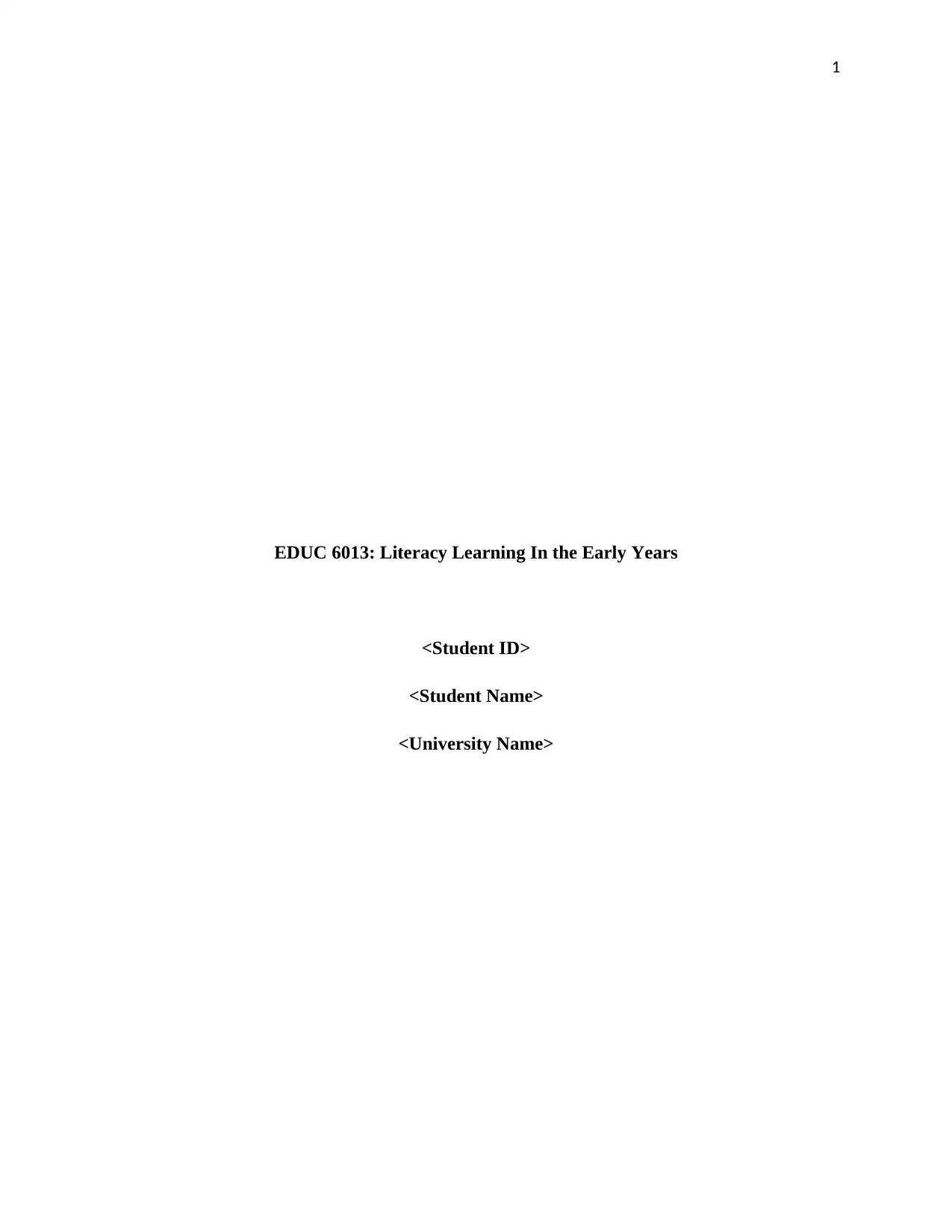
1
EDUC 6013: Literacy Learning In the Early Years
<Student ID>
<Student Name>
<University Name>
EDUC 6013: Literacy Learning In the Early Years
<Student ID>
<Student Name>
<University Name>
Paraphrase This Document
Need a fresh take? Get an instant paraphrase of this document with our AI Paraphraser
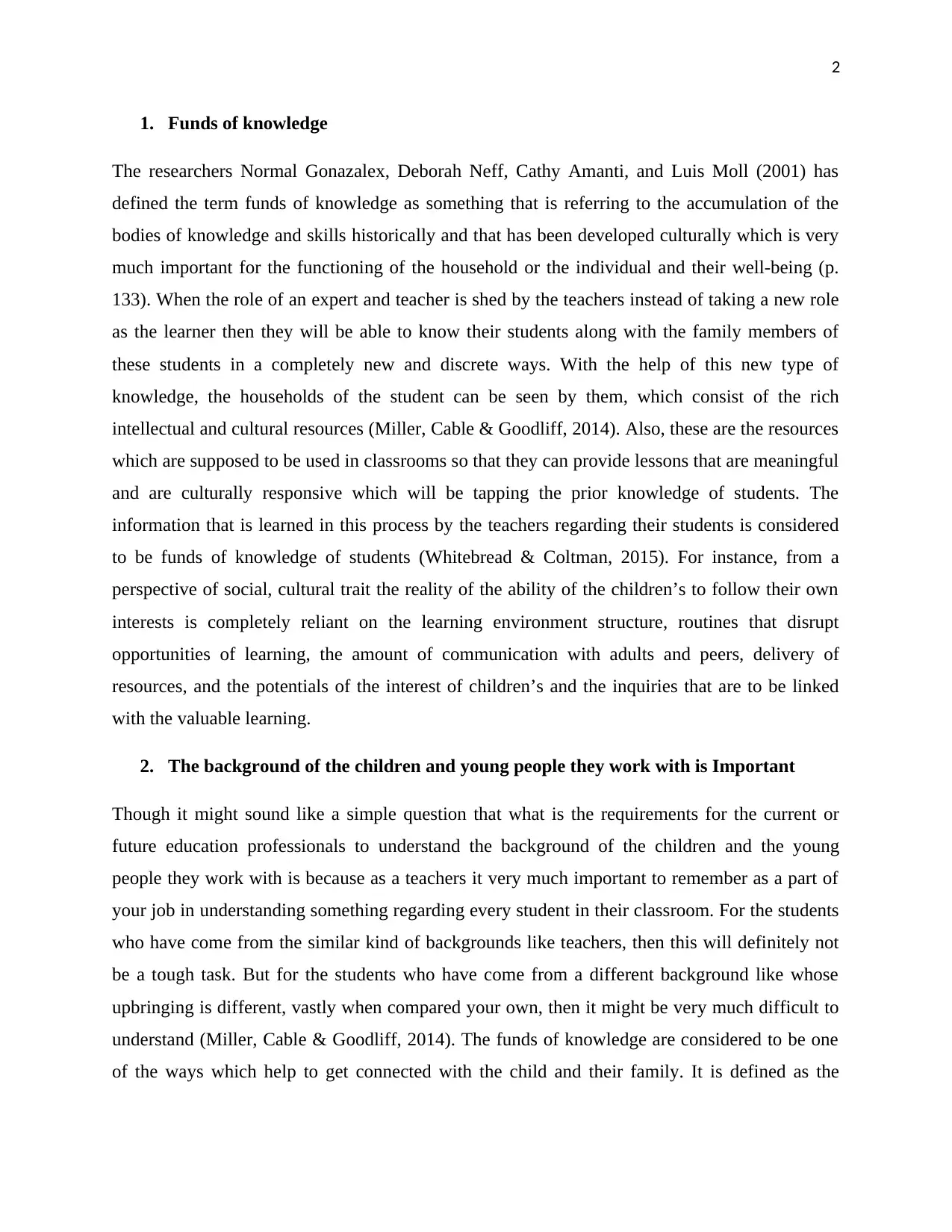
2
1. Funds of knowledge
The researchers Normal Gonazalex, Deborah Neff, Cathy Amanti, and Luis Moll (2001) has
defined the term funds of knowledge as something that is referring to the accumulation of the
bodies of knowledge and skills historically and that has been developed culturally which is very
much important for the functioning of the household or the individual and their well-being (p.
133). When the role of an expert and teacher is shed by the teachers instead of taking a new role
as the learner then they will be able to know their students along with the family members of
these students in a completely new and discrete ways. With the help of this new type of
knowledge, the households of the student can be seen by them, which consist of the rich
intellectual and cultural resources (Miller, Cable & Goodliff, 2014). Also, these are the resources
which are supposed to be used in classrooms so that they can provide lessons that are meaningful
and are culturally responsive which will be tapping the prior knowledge of students. The
information that is learned in this process by the teachers regarding their students is considered
to be funds of knowledge of students (Whitebread & Coltman, 2015). For instance, from a
perspective of social, cultural trait the reality of the ability of the children’s to follow their own
interests is completely reliant on the learning environment structure, routines that disrupt
opportunities of learning, the amount of communication with adults and peers, delivery of
resources, and the potentials of the interest of children’s and the inquiries that are to be linked
with the valuable learning.
2. The background of the children and young people they work with is Important
Though it might sound like a simple question that what is the requirements for the current or
future education professionals to understand the background of the children and the young
people they work with is because as a teachers it very much important to remember as a part of
your job in understanding something regarding every student in their classroom. For the students
who have come from the similar kind of backgrounds like teachers, then this will definitely not
be a tough task. But for the students who have come from a different background like whose
upbringing is different, vastly when compared your own, then it might be very much difficult to
understand (Miller, Cable & Goodliff, 2014). The funds of knowledge are considered to be one
of the ways which help to get connected with the child and their family. It is defined as the
1. Funds of knowledge
The researchers Normal Gonazalex, Deborah Neff, Cathy Amanti, and Luis Moll (2001) has
defined the term funds of knowledge as something that is referring to the accumulation of the
bodies of knowledge and skills historically and that has been developed culturally which is very
much important for the functioning of the household or the individual and their well-being (p.
133). When the role of an expert and teacher is shed by the teachers instead of taking a new role
as the learner then they will be able to know their students along with the family members of
these students in a completely new and discrete ways. With the help of this new type of
knowledge, the households of the student can be seen by them, which consist of the rich
intellectual and cultural resources (Miller, Cable & Goodliff, 2014). Also, these are the resources
which are supposed to be used in classrooms so that they can provide lessons that are meaningful
and are culturally responsive which will be tapping the prior knowledge of students. The
information that is learned in this process by the teachers regarding their students is considered
to be funds of knowledge of students (Whitebread & Coltman, 2015). For instance, from a
perspective of social, cultural trait the reality of the ability of the children’s to follow their own
interests is completely reliant on the learning environment structure, routines that disrupt
opportunities of learning, the amount of communication with adults and peers, delivery of
resources, and the potentials of the interest of children’s and the inquiries that are to be linked
with the valuable learning.
2. The background of the children and young people they work with is Important
Though it might sound like a simple question that what is the requirements for the current or
future education professionals to understand the background of the children and the young
people they work with is because as a teachers it very much important to remember as a part of
your job in understanding something regarding every student in their classroom. For the students
who have come from the similar kind of backgrounds like teachers, then this will definitely not
be a tough task. But for the students who have come from a different background like whose
upbringing is different, vastly when compared your own, then it might be very much difficult to
understand (Miller, Cable & Goodliff, 2014). The funds of knowledge are considered to be one
of the ways which help to get connected with the child and their family. It is defined as the
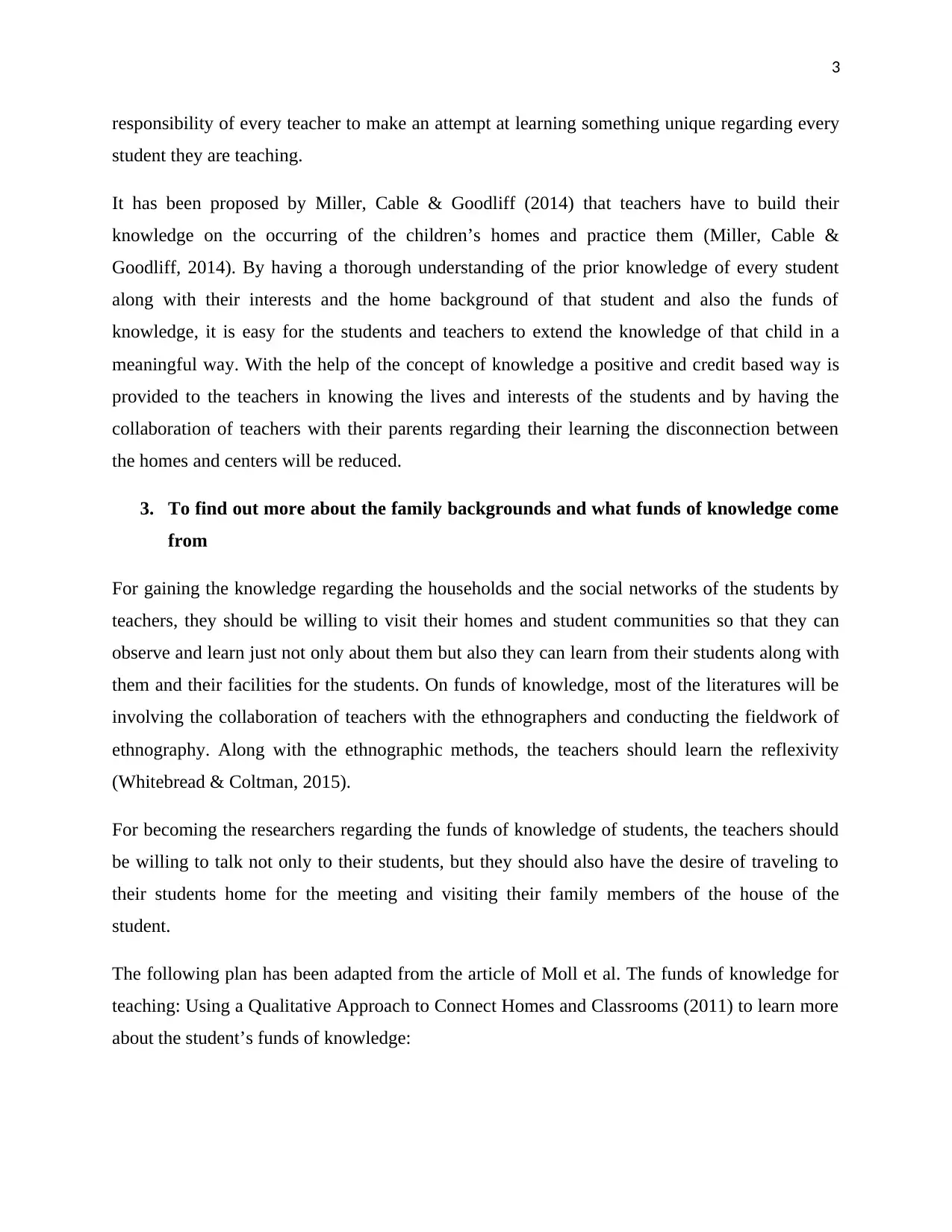
3
responsibility of every teacher to make an attempt at learning something unique regarding every
student they are teaching.
It has been proposed by Miller, Cable & Goodliff (2014) that teachers have to build their
knowledge on the occurring of the children’s homes and practice them (Miller, Cable &
Goodliff, 2014). By having a thorough understanding of the prior knowledge of every student
along with their interests and the home background of that student and also the funds of
knowledge, it is easy for the students and teachers to extend the knowledge of that child in a
meaningful way. With the help of the concept of knowledge a positive and credit based way is
provided to the teachers in knowing the lives and interests of the students and by having the
collaboration of teachers with their parents regarding their learning the disconnection between
the homes and centers will be reduced.
3. To find out more about the family backgrounds and what funds of knowledge come
from
For gaining the knowledge regarding the households and the social networks of the students by
teachers, they should be willing to visit their homes and student communities so that they can
observe and learn just not only about them but also they can learn from their students along with
them and their facilities for the students. On funds of knowledge, most of the literatures will be
involving the collaboration of teachers with the ethnographers and conducting the fieldwork of
ethnography. Along with the ethnographic methods, the teachers should learn the reflexivity
(Whitebread & Coltman, 2015).
For becoming the researchers regarding the funds of knowledge of students, the teachers should
be willing to talk not only to their students, but they should also have the desire of traveling to
their students home for the meeting and visiting their family members of the house of the
student.
The following plan has been adapted from the article of Moll et al. The funds of knowledge for
teaching: Using a Qualitative Approach to Connect Homes and Classrooms (2011) to learn more
about the student’s funds of knowledge:
responsibility of every teacher to make an attempt at learning something unique regarding every
student they are teaching.
It has been proposed by Miller, Cable & Goodliff (2014) that teachers have to build their
knowledge on the occurring of the children’s homes and practice them (Miller, Cable &
Goodliff, 2014). By having a thorough understanding of the prior knowledge of every student
along with their interests and the home background of that student and also the funds of
knowledge, it is easy for the students and teachers to extend the knowledge of that child in a
meaningful way. With the help of the concept of knowledge a positive and credit based way is
provided to the teachers in knowing the lives and interests of the students and by having the
collaboration of teachers with their parents regarding their learning the disconnection between
the homes and centers will be reduced.
3. To find out more about the family backgrounds and what funds of knowledge come
from
For gaining the knowledge regarding the households and the social networks of the students by
teachers, they should be willing to visit their homes and student communities so that they can
observe and learn just not only about them but also they can learn from their students along with
them and their facilities for the students. On funds of knowledge, most of the literatures will be
involving the collaboration of teachers with the ethnographers and conducting the fieldwork of
ethnography. Along with the ethnographic methods, the teachers should learn the reflexivity
(Whitebread & Coltman, 2015).
For becoming the researchers regarding the funds of knowledge of students, the teachers should
be willing to talk not only to their students, but they should also have the desire of traveling to
their students home for the meeting and visiting their family members of the house of the
student.
The following plan has been adapted from the article of Moll et al. The funds of knowledge for
teaching: Using a Qualitative Approach to Connect Homes and Classrooms (2011) to learn more
about the student’s funds of knowledge:
⊘ This is a preview!⊘
Do you want full access?
Subscribe today to unlock all pages.

Trusted by 1+ million students worldwide
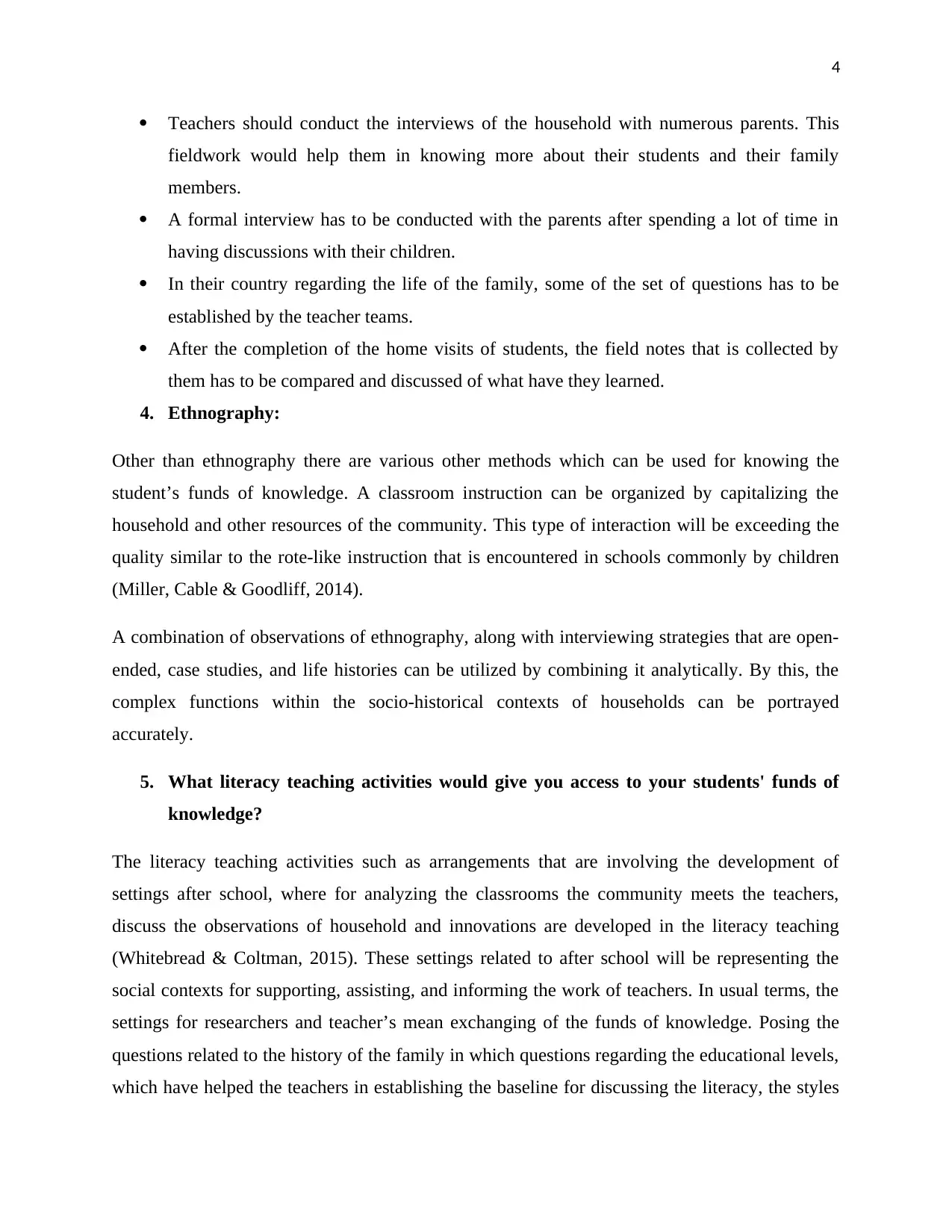
4
Teachers should conduct the interviews of the household with numerous parents. This
fieldwork would help them in knowing more about their students and their family
members.
A formal interview has to be conducted with the parents after spending a lot of time in
having discussions with their children.
In their country regarding the life of the family, some of the set of questions has to be
established by the teacher teams.
After the completion of the home visits of students, the field notes that is collected by
them has to be compared and discussed of what have they learned.
4. Ethnography:
Other than ethnography there are various other methods which can be used for knowing the
student’s funds of knowledge. A classroom instruction can be organized by capitalizing the
household and other resources of the community. This type of interaction will be exceeding the
quality similar to the rote-like instruction that is encountered in schools commonly by children
(Miller, Cable & Goodliff, 2014).
A combination of observations of ethnography, along with interviewing strategies that are open-
ended, case studies, and life histories can be utilized by combining it analytically. By this, the
complex functions within the socio-historical contexts of households can be portrayed
accurately.
5. What literacy teaching activities would give you access to your students' funds of
knowledge?
The literacy teaching activities such as arrangements that are involving the development of
settings after school, where for analyzing the classrooms the community meets the teachers,
discuss the observations of household and innovations are developed in the literacy teaching
(Whitebread & Coltman, 2015). These settings related to after school will be representing the
social contexts for supporting, assisting, and informing the work of teachers. In usual terms, the
settings for researchers and teacher’s mean exchanging of the funds of knowledge. Posing the
questions related to the history of the family in which questions regarding the educational levels,
which have helped the teachers in establishing the baseline for discussing the literacy, the styles
Teachers should conduct the interviews of the household with numerous parents. This
fieldwork would help them in knowing more about their students and their family
members.
A formal interview has to be conducted with the parents after spending a lot of time in
having discussions with their children.
In their country regarding the life of the family, some of the set of questions has to be
established by the teacher teams.
After the completion of the home visits of students, the field notes that is collected by
them has to be compared and discussed of what have they learned.
4. Ethnography:
Other than ethnography there are various other methods which can be used for knowing the
student’s funds of knowledge. A classroom instruction can be organized by capitalizing the
household and other resources of the community. This type of interaction will be exceeding the
quality similar to the rote-like instruction that is encountered in schools commonly by children
(Miller, Cable & Goodliff, 2014).
A combination of observations of ethnography, along with interviewing strategies that are open-
ended, case studies, and life histories can be utilized by combining it analytically. By this, the
complex functions within the socio-historical contexts of households can be portrayed
accurately.
5. What literacy teaching activities would give you access to your students' funds of
knowledge?
The literacy teaching activities such as arrangements that are involving the development of
settings after school, where for analyzing the classrooms the community meets the teachers,
discuss the observations of household and innovations are developed in the literacy teaching
(Whitebread & Coltman, 2015). These settings related to after school will be representing the
social contexts for supporting, assisting, and informing the work of teachers. In usual terms, the
settings for researchers and teacher’s mean exchanging of the funds of knowledge. Posing the
questions related to the history of the family in which questions regarding the educational levels,
which have helped the teachers in establishing the baseline for discussing the literacy, the styles
Paraphrase This Document
Need a fresh take? Get an instant paraphrase of this document with our AI Paraphraser
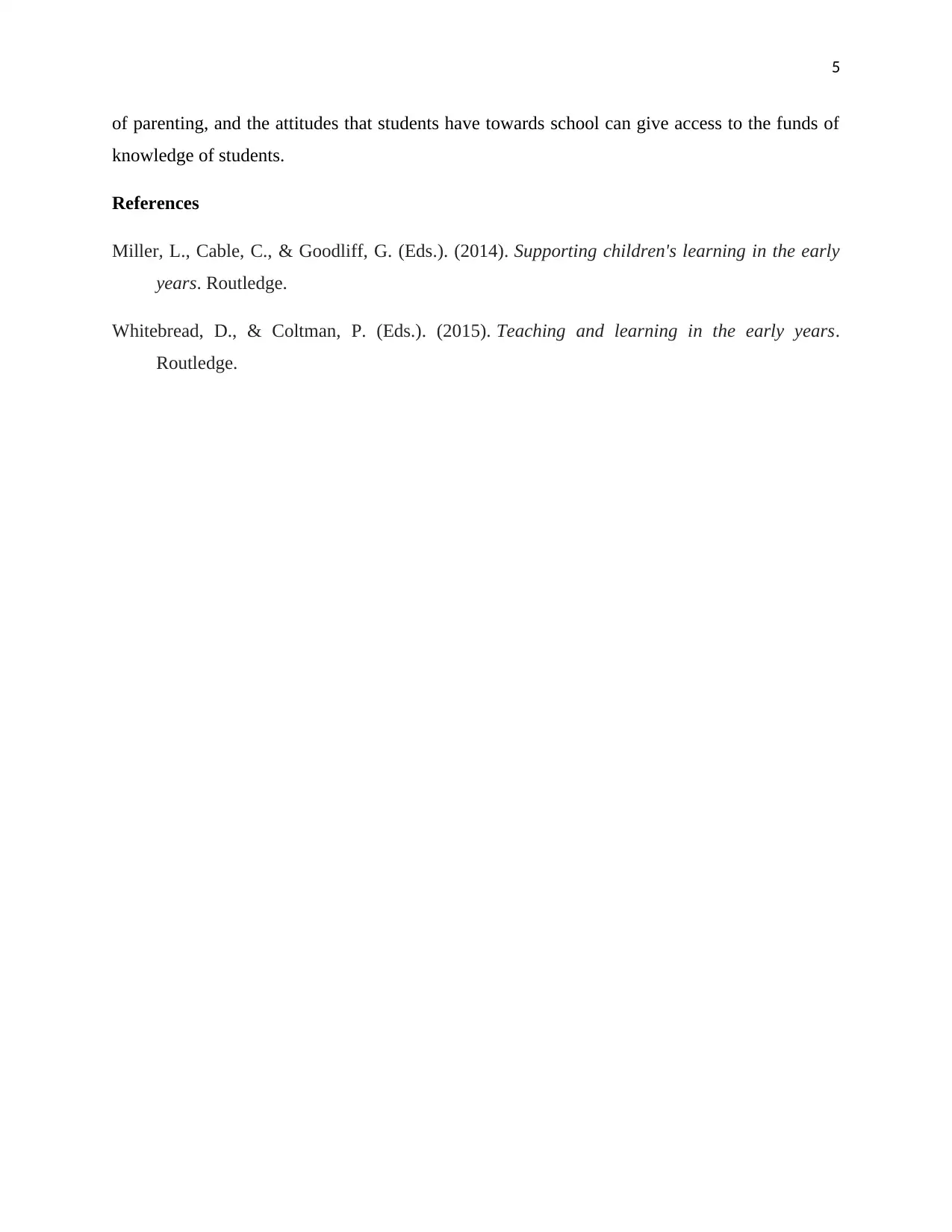
5
of parenting, and the attitudes that students have towards school can give access to the funds of
knowledge of students.
References
Miller, L., Cable, C., & Goodliff, G. (Eds.). (2014). Supporting children's learning in the early
years. Routledge.
Whitebread, D., & Coltman, P. (Eds.). (2015). Teaching and learning in the early years.
Routledge.
of parenting, and the attitudes that students have towards school can give access to the funds of
knowledge of students.
References
Miller, L., Cable, C., & Goodliff, G. (Eds.). (2014). Supporting children's learning in the early
years. Routledge.
Whitebread, D., & Coltman, P. (Eds.). (2015). Teaching and learning in the early years.
Routledge.
1 out of 5
Related Documents
Your All-in-One AI-Powered Toolkit for Academic Success.
+13062052269
info@desklib.com
Available 24*7 on WhatsApp / Email
![[object Object]](/_next/static/media/star-bottom.7253800d.svg)
Unlock your academic potential
Copyright © 2020–2025 A2Z Services. All Rights Reserved. Developed and managed by ZUCOL.





